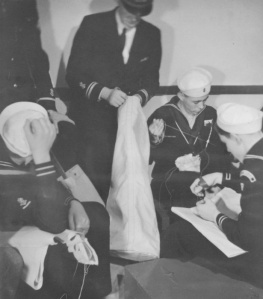There are many volunteers who dedicated their lives to building Sea Scouts into a century old program; many now known only known to Time. Some of the early great leaders include the following:
Commander Thomas J. Keane, National Sea Scout Director
Dr. William Menninger, National Sea Scout Committee Member, author of the 1939 Handbook for Skippers, and noted psychiatrist
Carl D. Lane, author of the 1939 Sea Scout Manual and Handbook for Crew Leaders (Now Reprinted by Kessinger Publishing LLC)
 The 1920s to 1940s witnessed significant growth in Sea Scouts. In 1925, there were 85 Sea Scout Ships and 1,110 Sea Scouts. In 1934, the number of Sea Scouts increased to 19,448 and 1,041 Ships. (See, The History of Sea Scouting in the United States).
The 1920s to 1940s witnessed significant growth in Sea Scouts. In 1925, there were 85 Sea Scout Ships and 1,110 Sea Scouts. In 1934, the number of Sea Scouts increased to 19,448 and 1,041 Ships. (See, The History of Sea Scouting in the United States).
There are now 7,205 Sea Scouts, as of May 2011 (68% male, 32% female).
There are many reasons for the program growth ushered in by Commander Keane and his contemporaries. Part of the growth can be attributed to the amazing training resources for youth and volunteers.
Dr. William Menninger’s Handbook for Skippers outlined the psychological underpinnings of why youth enjoy being a Sea Scout. Dr. Menninger’s 72-year-old material is still highly relevant in understanding why youth dedicate their time to being a Sea Scout.
Quotes and summaries from Menninger’s Handbook for Skippers:
Psychology of Sea Scouting
1. Adventure
 Young people seek adventure and Sea Scouting is an excellent outlet for providing opportunities to cruise on boats, camp by lakes and other maritime activities.
Young people seek adventure and Sea Scouting is an excellent outlet for providing opportunities to cruise on boats, camp by lakes and other maritime activities.
2. Challenge to the Intellect
Young [people] of today are living in an era which is predominately scientific. They demand participation in an intellectual atmosphere which reaches up to their real or self-assumed intellectual capacity. Sea Scouting challenges the intellect of a young [person] in various ways. One of the most interesting is the necessity for Sea Scouts to learn how to take care of themselves on the water. In order to learn how to handle boats safely, it is necessary for them to study seamanship, piloting, navigation, weather lore, astronomy, carpentry, and many other activities which are of interest to [youth] their age. The study of these activities with the purpose of practicing them for actual use on a challenging adventure, is very satisfying. Another very important matter which is sometimes overlooked by Skippers who have not had experience as Scoutmasters, is the vocational interest and Merit Badge work, especially those badges that pertain to water and the out-of-doors.
3. Recognition of Accomplishments
 Sea Scouting recognizes that in an age when hero worship is prevalent, the desire for young [people] to receive recognition for their intellectual and physical achievements is tremendous… This desire for recognition of accomplishments is also satisfied by the inauguration of the principle, “Rank has its Privileges and its Obligations”
Sea Scouting recognizes that in an age when hero worship is prevalent, the desire for young [people] to receive recognition for their intellectual and physical achievements is tremendous… This desire for recognition of accomplishments is also satisfied by the inauguration of the principle, “Rank has its Privileges and its Obligations”
4. Desire for Distinguishing Mark
Sea Scout Uniforms, Badges and Insignia distinguish a Sea Scout as part of the older youth program. The pride shown in Sea Scout uniforms highlights the importance of this psychological motivation.
5. Desire for Rituals
There is a desire in people to belong to an exclusive group with its own traditions.
6. Desire for Athletic Competition
 The age-old desire of youth to express its physical power has come down through the ages and is so well known as to be proverbial….In Sea Scouting it has been found very easy to satisfy this desire by working into program athletic activities of a type essential to advancement in the various ranks of the program including such aquatic activities as life saving, swimming, rowing and sailing.
The age-old desire of youth to express its physical power has come down through the ages and is so well known as to be proverbial….In Sea Scouting it has been found very easy to satisfy this desire by working into program athletic activities of a type essential to advancement in the various ranks of the program including such aquatic activities as life saving, swimming, rowing and sailing.
7. The Social Urge
Sea Scouts provides opportunities for young people to associate with others in properly supervised social settings.
8. The Challenge to Life
Sea Scouts provides character building for young people to face the challenges of life.
Dr. Menninger concluded his chapter that a Sea Scout Ship will succeed if its program meets all 8 points of the underlying psychology of Sea Scouting. While some of the language is dated, the elements of why youth participate in Sea Scouts is not fundamentally different since the founding of Sea Scouts in the United States.